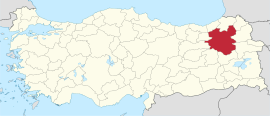Erzurum Province
Erzurum Province
Erzurum ili | |
|---|---|
 | |
 Location of the province within Turkey | |
| Country | Turkey |
| Seat | Erzurum |
| Government | |
| • Mayor | Mehmet Sekmen (AKP) |
| • Vali | Mustafa Çiftçi |
| Area | 25,006 km2 (9,655 sq mi) |
| Population (2022)[1] | 749,754 |
| • Density | 30/km2 (78/sq mi) |
| Time zone | UTC+3 (TRT) |
| Area code | 0442 |
| Website | www |
Erzurum Province (
Geography
The surface area of the province of Erzurum is the fourth biggest in Turkey. The majority of the province is
Continental climate rules in the province with long and harsh winters, and short and mild summers.
The eastern part of the province lies in the
There are few natural lakes in the province, the major one being Lake Tortum (approximately 8 km2) fed by the Tortum (Uzundere) Falls. The Tortum hydroelectric power plant built in 1963 is situated on the inlet of this lake. There are three artificial lakes in the province.
Districts


History

Known as Karanitis (
In the Ottoman Empire
In 1514, the region was conquered by the

The Ottomans were routed by the
Beginning in late 1914 and picking up in the summer of 1915, the province saw the wholesale extermination of the Armenian population by state-sponsored forces as part of the Armenian genocide.[11]
The province was the site of the major fighting during
In Turkey
In September 1935 the third
Economy
Historically, Erzurum produced
Approximately 18.5% of the total surface area is arable land, of which about 75% has permanent crops. A large portion of the agricultural produce comprises cereals. Forested areas occupy 8.8% of the total surface area, with forestry a local industry. Industries largely consist of manufacturing of forestry, agriculture, husbandry, chemistry, textile and mining products. There are 81 active industrial plants in the province, most of them located at the central district of Erzurum, and are small and medium enterprises. Due to their relatively small sizes, these industries mainly serve local markets causing lower capacity usage, low productivity and unemployment. About 40 plants are currently out of use, mostly due to high operating costs.
The province of Erzurum has the highest ratio of meadows and pastures in Turkey, ideal for livestock. However, once the main occupation,
Mining resources include
resources, except one, are not suitable for economic investments, and they are used as natural springs.The gross domestic product
Transportation is possible via paved and unpaved highways. The Erzurum international airport is open for commercial flights and is also used by the Turkish Air Force. The runways of this airport are the second longest in Turkey. Erzurum is also the main railroad hub in the Eastern Anatolia Region.
The largest contributor to the provincial economy, in recent years, has been Atatürk University, which is also one of the largest universities in Turkey, having more than forty thousand students. Tourist activities, which include skiing, rafting, and mountaineering, also provide a substantial proportion of the province's income. Skiing is centered on Palandöken Mountain.
Places of Interest
- Öşvank (Oshk Vank) Historical Georgian Monastery church, Uzundere.
- Bana cathedral, also known as the Penek cathedral
- Oltu Russian cathedral, also known as Oltu Rus Kilisesi
- Haho Khakhuli Monastery, also known as Haho Bağbaşı Kilisesi, is a Georgian Orthodox monastery in historical Medieval Georgian Kingdom of Tao, located in Tortum.
Notable people
- Nene Hatun, Turkish folk heroine who fought in the Russo-Turkish War of 1877–1878
References
- ^ TÜİK. Retrieved 19 September 2023.
- ^ "İl ve İlçe Yüz ölçümleri". General Directorate of Mapping. Retrieved 19 September 2023.
- ^ "Vali Mustafa ÇİFTÇİ". Erzurum Valiliği. Retrieved 23 October 2023.
- ^ Gürses, Mehmet (28 February 2019). Anatomy of a Civil War: Sociopolitical Impacts of the Kurdish Conflict in Turkey. University of Michigan Press. p. 56. Retrieved 20 November 2022.
- ^ "Karasu-Aras Dağları'nın güney yamaçlarında Doğubeyazıt bölgesi erken demir çağı yerleşmeleri" (in Turkish). Barış Gür- Amisos. February 26, 2022. p. 1.
- ^ a b Smith, William (1852). Dictionary of Greek and Roman Geography (Abacaenum – Hytanis). p. 514. Boston: Little, Brown.
- ^ "Erzurum (Theodosiopolis)". Catholic Encyclopedia.
- ISBN 90-429-1318-5
- ISBN 9789004097384.
- ISBN 978-1135954949p 506
- ^ Kévorkian, Raymond. The Armenian Genocide: A History (London: I.B. Tauris, 2011), pp. 289-318.
- ISBN 978-0-300-15260-9.
- ^ a b "Üçüncü Umumi Müfettişliği'nin Kurulması ve III. Umumî Müfettiş Tahsin Uzer'in Bazı Önemli Faaliyetleri". Dergipark. p. 2. Retrieved 8 April 2020.
- ISBN 978-1-317-09579-8.
- ISBN 978-0-521-62096-3.
- ^ Prothero, W.G. (1920). Armenia and Kurdistan. London: H.M. Stationery Office. p. 60.
- ^ Prothero, W.G. (1920). Armenia and Kurdistan. London: H.M. Stationery Office. p. 62.
- ^ Prothero, W.G. (1920). Armenia and Kurdistan. London: H.M. Stationery Office. p. 64.
- ^ a b Prothero, W.G. (1920). Armenia and Kurdistan. London: H.M. Stationery Office. p. 72.
